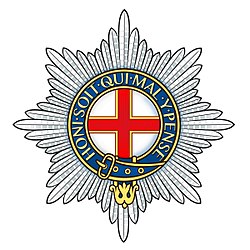Coldstream Guards
| The Coldstream Guards | |
|---|---|

Regimental badge of the Coldstream Guards
|
|
| Active | 1650–present |
| Country |
(1660–1707) (1801–present) |
| Branch |
|
| Type | Foot Guards |
| Role | 1st Battalion – Light infantry No 7 Company – Public Duties |
| Size | One battalion One independent company |
| Part of | Guards Division |
| Garrison/HQ | RHQ – London 1st Battalion – Victoria Barracks, Windsor No 7 Company – London |
| Nickname(s) | The Lilywhites |
| Motto(s) |
"" (Latin) "Second to None" |
| March | Quick – Milanollo Slow – Figaro ("Non più andrai" from The Marriage of Figaro) |
| Anniversaries | St George's Day (April 23) |
| Engagements |
English Civil War Monmouth Rebellion War of the Spanish Succession War of the Austrian Succession Seven Years' War American War of Independence Napoleonic Wars Crimean War Second Boer War The Great War Second World War Malayan Emergency Mau Mau Uprising Cyprus Emergency Gulf War Bosnia Iraq War Operation Herrick |
| Commanders | |
| Colonel in Chief | HM The Queen |
| Colonel of the Regiment |
Lieutenant General Sir James Bucknall, KCB, CBE |
| Insignia | |
| Tactical Recognition Flash |  |
| Plume | Red Right side of Bearskin cap |
| Abbreviation | COLDM GDS |
The Coldstream Guards (COLDM GDS) is a part of the Guards Division,Foot Guards regiments of the British Army.
It is the oldest regiment in the Regular Army in continuous active service, originating in Coldstream, Scotland in 1650 when General George Monck founded the regiment. It is one of two regiments of the Household Division that can trace its lineage to the New Model Army, the other being the Blues and Royals (Royal Horse Guards and 1st Dragoons).
The origin of The Coldstream Guards lies in the English Civil War when Oliver Cromwell gave Colonel George Monck permission to form his own regiment as part of the New Model Army. Monck took men from the regiments of George Fenwick and Sir Arthur Haselrig, five companies each, and on 23 August 1650 formed Monck's Regiment of Foot. Less than two weeks later this force took part in the Battle of Dunbar, at which the Roundheads defeated the forces of Charles Stuart.
After Richard Cromwell's abdication, Monck gave his support to the Stuarts, and on 1 January 1660 he crossed the River Tweed into England at the village of Coldstream, from where he made a five-week march to London. He arrived in London on 2 February and helped in the Restoration of the monarchy. For his help, Monck was given the Order of the Garter and his regiment was assigned to keep order in London. However, the new parliament soon ordered his regiment to be disbanded with the other regiments of the New Model Army.
...
Wikipedia
